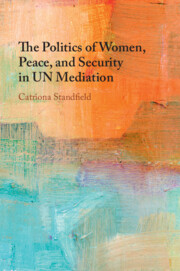70 results
Of Jungles, Deserts, and Bandits: State-Sanctioned Danger in the Border Regimes of 1940s ‘Aden and 2020s America
- Part of
-
- Journal:
- Public Humanities / Volume 1 / 2025
- Published online by Cambridge University Press:
- 02 April 2025, e64
-
- Article
-
- You have access
- Open access
- HTML
- Export citation
South Arabian etymology for the Meccan Kaʿbah
-
- Journal:
- Bulletin of the School of Oriental and African Studies , First View
- Published online by Cambridge University Press:
- 13 March 2025, pp. 1-11
-
- Article
- Export citation
‘Offshoring’ Weapons Production and Implications for Export Controls: Lessons from South Africa
-
- Journal:
- Business and Human Rights Journal , First View
- Published online by Cambridge University Press:
- 14 February 2025, pp. 1-7
-
- Article
-
- You have access
- Open access
- HTML
- Export citation
2 - The WPS Agenda and UN Mediation
-
- Book:
- The Politics of Women, Peace, and Security in UN Mediation
- Published online:
- 19 December 2024
- Print publication:
- 02 January 2025, pp 32-60
-
- Chapter
- Export citation
6 - Femininities in UN Mediation
- from Part III - Subjects
-
- Book:
- The Politics of Women, Peace, and Security in UN Mediation
- Published online:
- 19 December 2024
- Print publication:
- 02 January 2025, pp 141-162
-
- Chapter
- Export citation

The Politics of Women, Peace, and Security in UN Mediation
-
- Published online:
- 19 December 2024
- Print publication:
- 02 January 2025
Redefining the neutral intermediary role: Balancing theoretical ideas with practical realities through the ICRC's experience in Yemen
-
- Journal:
- International Review of the Red Cross / Volume 106 / Issue 927 / December 2024
- Published online by Cambridge University Press:
- 31 October 2024, pp. 1065-1087
- Print publication:
- December 2024
-
- Article
-
- You have access
- HTML
- Export citation
From Paris to Ṭā’if: Sovereignty, Borders, and the Question of Minorities in the Arabian Peninsula
-
- Journal:
- Nationalities Papers , FirstView
- Published online by Cambridge University Press:
- 17 October 2024, pp. 1-21
-
- Article
-
- You have access
- Open access
- HTML
- Export citation
21 - The Mongols and the Arab Middle East
- from Volume I Part 4 - External Histories
-
-
- Book:
- The Cambridge History of the Mongol Empire
- Published online:
- 01 January 2024
- Print publication:
- 17 August 2023, pp 798-826
-
- Chapter
- Export citation
Concurrent wasting and stunting among marginalised children in Sana’a city, Yemen: a cross-sectional study
-
- Journal:
- Journal of Nutritional Science / Volume 12 / 2023
- Published online by Cambridge University Press:
- 04 August 2023, e91
-
- Article
-
- You have access
- Open access
- HTML
- Export citation
2 - Intervention by Invitation
-
-
- Book:
- Armed Intervention and Consent
- Published online:
- 22 June 2023
- Print publication:
- 06 July 2023, pp 101-178
-
- Chapter
-
- You have access
- Open access
- HTML
- Export citation
3 - Invitations to Intervene after the Cold War
-
-
- Book:
- Armed Intervention and Consent
- Published online:
- 22 June 2023
- Print publication:
- 06 July 2023, pp 179-318
-
- Chapter
-
- You have access
- Open access
- HTML
- Export citation
7 - Cultural Exchange and Religious Guidance along the Shores of the Arabian Sea
- from Part ii - South Asia: Identity and Culture in British and Independent India
-
-
- Book:
- Jewish Communities in Modern Asia
- Published online:
- 11 August 2023
- Print publication:
- 15 June 2023, pp 127-142
-
- Chapter
- Export citation
7 - Yemen
-
- Book:
- The Struggle for Supremacy in the Middle East
- Published online:
- 09 March 2023
- Print publication:
- 16 March 2023, pp 215-249
-
- Chapter
- Export citation

The Struggle for Supremacy in the Middle East
- Saudi Arabia and Iran
-
- Published online:
- 09 March 2023
- Print publication:
- 16 March 2023
5 - Two Tales of Decentralization
- from Part III - Embattled Revolutionary Legacies (2014–2021)
-
- Book:
- Violence and Representation in the Arab Uprisings
- Published online:
- 02 February 2023
- Print publication:
- 09 February 2023, pp 283-322
-
- Chapter
- Export citation

Violence and Representation in the Arab Uprisings
-
- Published online:
- 02 February 2023
- Print publication:
- 09 February 2023
18 - Decentralization in Yemen
- from Part IV - Decentralization, Conflict, and State Fragmentation
-
-
- Book:
- Federalism and Decentralization in the Contemporary Middle East and North Africa
- Published online:
- 15 January 2023
- Print publication:
- 05 January 2023, pp 365-384
-
- Chapter
- Export citation
19 - Federalism and Decentralization in the MENA Region
- from Part V - Conclusions
-
-
- Book:
- Federalism and Decentralization in the Contemporary Middle East and North Africa
- Published online:
- 15 January 2023
- Print publication:
- 05 January 2023, pp 387-416
-
- Chapter
- Export citation
The derivatives of Barth's Law in the light of modern Arabic dialects
-
- Journal:
- Bulletin of the School of Oriental and African Studies / Volume 85 / Issue 3 / October 2022
- Published online by Cambridge University Press:
- 28 February 2023, pp. 333-353
- Print publication:
- October 2022
-
- Article
-
- You have access
- Open access
- HTML
- Export citation


